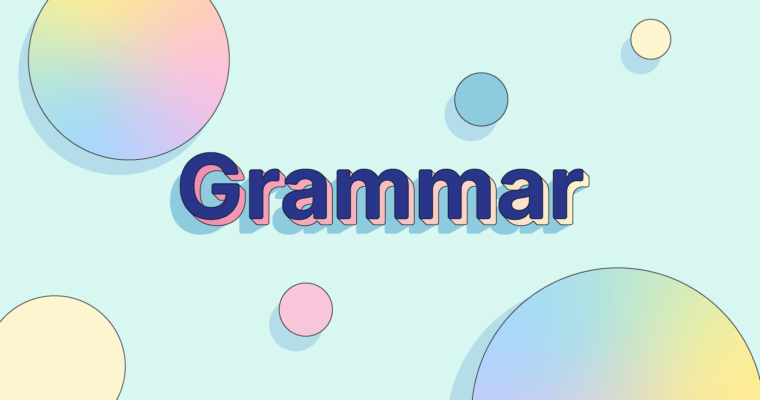
Sentence structure is how all the parts of a sentence fit together. If you want to make more advanced and interesting sentences, you first have to understand how sentence structure works.
Below, we explain the rules for all types of sentence structure so that you can communicate clearly, correctly, and confidently. But before we dive into the details, let’s start by reexamining the basics.
What is sentence structure?
Sentence structure is the order of all the parts in a sentence: subject, predicate, objects, phrases, punctuation, etc. It deals a lot with independent and dependent clauses and how they combine (explained below), the placement of words and phrases next to what they modify, as well as the use of proper grammar.
Basic parts of a sentence
Every sentence requires at least a verb and a subject; a verb is an action, and a subject is the noun that does the action.
I am waiting.
In this example, am waiting is the verb. The main verb is wait, but when we conjugate it in the present continuous, we use the –ing form and add the auxiliary verb am. The subject is I, the person who waits.
The exception to this rule is imperative sentences (commands), which only need a verb. We can assume the subject is the person the speaker is talking to.
Stop!
This single word is a complete sentence. The verb is stop, and no subject is necessary because it’s a command.
Some sentences can add objects, which are nouns that also participate in the action. Let’s say you forgot your calculator and you ask your friend to borrow theirs.
My buddy lends me their calculator.
In this example, lends is the verb and my buddy is the subject because they’re the one lending. The word calculator is what’s called a direct object, the noun that receives the action. In this case, the direct object is the thing being lent—a calculator.
The indirect object is the noun that receives the direct object. In the example above, the indirect object is me, because that’s who receives the calculator. Indirect objects come between the verb and direct object.
Did you notice that the subject uses the pronoun I but the objects use the pronoun me? Subject and object pronouns are different, so make sure you’re using the right one.
Only a certain type of verb called transitive verbs can use direct and indirect objects. However, transitive verbs are quite common, so you’ll be using them a lot.
Let’s look at another example.
Herrera passes Mbappé the ball.
Can you identify the verb, subject, direct object, and indirect object?
- The verb is passes because that’s the action in the sentence.
- The subject is Herrera because Herrera is the person who passes.
- The direct object is the ball because the ball is the thing being passed.
- The indirect object is Mbappé because Mbappé receives the ball.
4 sentence structure grammar rules
Aside from knowing the parts of a sentence, you also have to follow the grammar rules. In case you forget, here’s a quick list:
- Capitalize the first letter of the first word in a sentence.
- End a sentence with a period, question mark, exclamation point, or quotation marks.
- Most of the time, the subject of the sentence comes first, the verb comes second, and the objects come last. (Subject -> Verb -> Object)
- If the subject is singular, the verb must also be singular. If the subject is plural, the verb must be plural. This is known as subject-verb agreement.
Types of clauses
If every sentence were as simple as subject + verb + object, books would be so boring! That’s why English has developed a few different sentence structures to keep things interesting and give us more options for speaking and writing.
Before we get into those different sentence structures, it’s crucial to understand how clauses work. A clause is a group of words that contains a subject and a verb. Sometimes a clause is a complete sentence on its own, but other times it needs help before it expresses a complete thought.
A clause that is a complete sentence is called an independent clause. It contains everything you need for a complete sentence: subjects and verbs, with objects optional.
We’ll eat dinner at five.
Faria and Bertuccio assisted the Count of Monte Cristo.
A clause that is not a complete sentence is called a dependent clause, or subordinate clause. These support independent clauses, usually by adding necessary information.
The roads are icy because it rained last night.
This sentence contains two clauses: (1) The roads are icy and (2) because it rained last night. Each sentence has a subject (the roads & it) and a verb (are & rained), but only the first clause is a complete sentence by itself.
Notice that the subordinate clause because it rained last night slightly changes the meaning of the first sentence by adding new and important information. That’s the main purpose of subordinate clauses—to improve an independent clause with essential details.
Although subordinate clauses have both subjects and verbs, they cannot exist on their own. They contain special words called subordinating conjunctions, which connect them to independent clauses.
Common subordinating conjunctions include because, since, although, unless, and while, as well as relative pronouns like that, which, whatever, whenever, whoever, etc.
If you see a subordinating conjunction, it means that group of words is a subordinate clause. It helps to memorize them so you can easily identify different clauses. You can find a complete list of subordinating conjunctions here.
4 types of sentence structure
Depending on how you combine clauses, you can create four different types of sentence structure:
- Simple: 1 independent clause
- Compound: 2 or more independent clauses
- Complex:1 independent clause + 1 or more subordinate clauses
- Compound-Complex: 2 or more independent clauses + 1 or more subordinate clauses
Note: Sentences are also categorized by their function, i.e., declarative, interrogative, exclamation, and imperative. These are separate from the types of sentence structure (complex, compound, etc.), and the two categories can be mixed and matched. To read more about each, check out our guide on the types of sentences.
Let’s take a deeper look at each type of sentence structure and how to form it.
Simple sentences
Simple sentences are pretty simple: just a single independent clause, no more, no less. This includes subject and verbs, but can also include objects.
“Life itself is the most wonderful fairy tale.”—Hans Christian Anderson
“Real glory springs from the silent conquest of ourselves.”—Joseph P. Thompson
Compound sentences
A compound sentence joins together two or more independent clauses into a single sentence. You can connect the independent clauses in two ways:
- Using a comma and a coordinating conjunction (for, and, nor, but, or, yet, and so, known as FANBOYS) between the clauses.
- Using a semicolon between the clauses.
“It may seem difficult at first, but everything is difficult at first.”—Miyamoto Musashi
“Be yourself; everyone else is already taken.”—Oscar Wilde
“We know they are lying, they know they are lying, they know we know they are lying, we know they know we know they are lying, but they are still lying.”—Aleksandr Isayevich Solzhenitsyn
Complex sentences
A complex sentence uses one main independent clause with any number of subordinate clauses. While compound sentences use coordinating conjunctions to join the clauses together, complex sentences use subordinating conjunctions, explained earlier.
If the subordinating clause comes first, use a comma before the independent clause. If the independent clause comes first, you don’t need a comma at all.
“Until the lion learns to write, every story will glorify the hunter.”—African proverb
“When a person can’t find a deep sense of meaning, they distract themselves with pleasure.”—Viktor Frankl
“It is during our darkest moments that we must focus to see the light.”—Aristotle
Compound-complex sentences
As the name suggests, compound-complex sentences combine compound sentences with complex sentences. They require at least two independent clauses and at least one subordinating clause. To combine them, follow the specific grammar rules for each; be sure you’re using your coordinating conjunctions and subordinating conjunctions in the right places.
“If you’re going to be crazy, you have to get paid for it, or else you’re going to be locked up.”—Hunter S. Thompson
“Don’t aim for success if you want it; just do what you love and believe in, and it will come naturally.”—David Frost
Need help with sentence structure?
Sentence structure can get pretty complicated, especially at first when learning the differences between clauses and conjunctions. To help you out, Grammarly gives you suggestions on how to transform whole sentences for clarity. Try our AI sentence rewriter, which makes it easy to rewrite sentences for research papers, emails, and more in just a few clicks.


